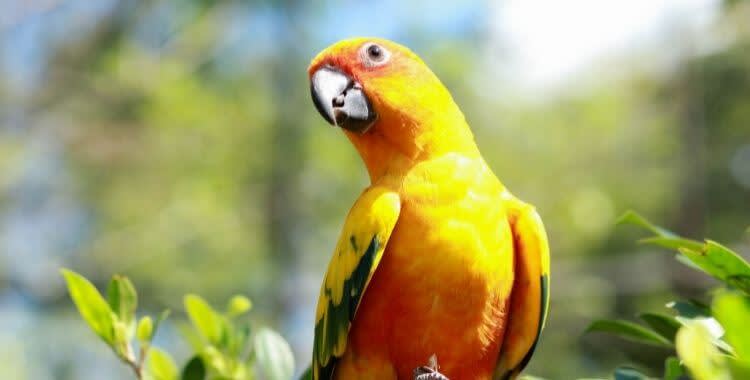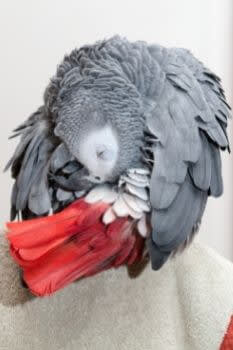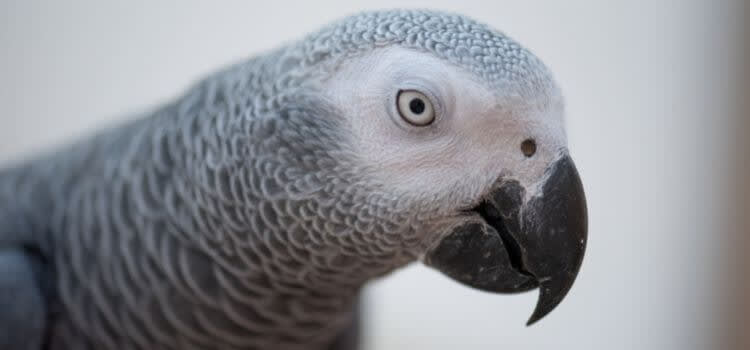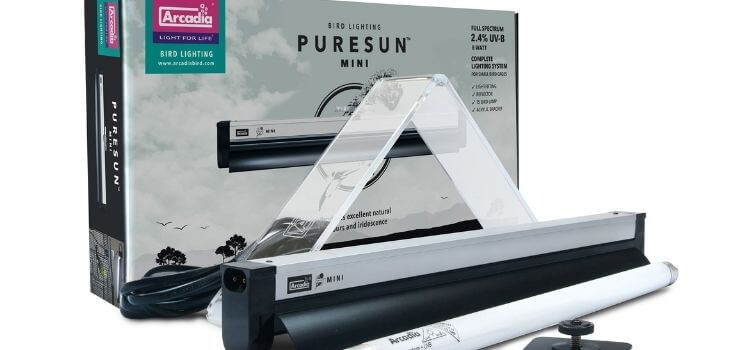Birds can see within the UV spectrum, which helps with food identification, choosing a mate, plumage and health.
Is your parrot insured? Get a quote for up to £5,000 of vet fee cover, death and theft cover | We’ve been insuring exotic pets since 1996 | Check out our customer reviews on Feefo.
John Courteney-Smith MRSB FLS is Head of Science and Innovation at Arcadia Reptile and David Alderton is an expert in reptile and pet care.
How birds see using UV lighting | Benefits of the UV spectrum | Impacts on plumage | Other benefits of UV on birds | Understanding UV lighting | Specialist lamps | Understanding T references on lamps
Unlike ordinary light bulbs, specialist lamps produced for birds (and reptiles) will produce light from the visible spectrum, and significantly, a percentage of ultraviolet (UV) light too.
UV wavelengths are part of the sun’s usual output, and they have a direct impact on our planet’s life.

How birds see using UV lighting
UVA is the part of the UV spectrum that is closest to visible light, and comprises the largest part of the UV light from the sun.
UVA has a wavelength of 320-400nm and is vital for a bird’s vision.
This is because they can see within the UV part of the spectrum, which is invisible to us.
As such, along with reptiles and some fish, they have the ability to appreciate a much wider range of colours than us.
This is described as ‘tetrachromatic vision’ because there are four (‘tetra’) types of cone cell on the retina at the back of the eye.
This is where the image forms, and which respond to daylight. These cone cells are sensitive to red, green and blue as well as UV light. The impact on their vision is dramatic.
Humans who have trichromatic vision can see approximately one million colours.
But birds and other animals possessing tetrachromatic vision can see around 100 million colours.
The subject is even more complex as every species has further adaptations to the eye, therefore seeing things in a slightly different way to other species.
In summary, almost all birds use UVA to view the world, but not all birds see it in exactly the same way.
The benefits of seeing in the UV spectrum
The ability to see within UV spectrum brings a number of survival advantages.
It means that birds can pick out certain fruits and insects that stand out to them even when partly hidden, thanks to their ability to see UV light.
Perhaps more remarkably the tetrachromatic vision of birds can also help them to find a mate.
In instances when the plumage appears to be identical to us in both sexes, the feathers, legs and beak seem to glow under UVA light.
In fact, there is evidence to show that UV light is even important in enabling birds to choose healthy mates.
Birds that are out of condition or sick will have poor feathering, because they will not have been preening themselves properly.
Impacts on plumage
The preen (uropygial) gland is located under the feathers as a raised area at the base of the tail. This produces an oil that is used to coat the feathers and it used to be thought that this was simply to waterproof them.
It is now known this oil also contains precursors of vitamin D3. These are activated by exposure to UV light, creating the active form of the vitamin.
It is likely that the bird will be swallowing some of the vitamin D3, supplementing its uptake through the skin, while preening itself with this oil.
Learn about the relationship between vitamin D3 and UV light in Part one: The importance of UV lighting for birds.
In addition, a potential mate will also be able to spot the presence of this oil on the feathers.
It is thought the oil is more conspicuous under UV light, meaning it acts as an identifier for healthy birds who are regularly preening.
Below is an African grey parrot coating the top of its head with oil from its preen gland during preening.

Other benefits of UV on birds
The impact may go deeper too, in terms of the body’s function and UV exposure.
Plumage: Male strawberry finches (Amandava amandava) are normally red in colour when in breeding season. But if kept indoors, with no access to UV, their new plumage is likely to be black rather than red. This is the result of dark melanin pigment accumulating in the feathers.
However, the change is reversible at the next moult, with exposure to UV light, a high enough quantity of visible light and full-spectrum carotenoids.
For clarity – a carotenoid is a natural colour pigment that is taken up into the bird’s plumage from its diet when it is moulting, creating red colouration.
In this way, the energy contained within light works with nutritional compounds to allow the creation of this vibrant red colour.
Feeding hatchlings: A bird’s reliance on UVA may begin right at the start of its life, being evident in the nest in some cases.
The chicks of certain Australian finches have UV-reflective spots in their mouths, to show the parent bird they are wanting to be fed when they open them.
Face exposure: In other cases, such the African grey parrot (Psittacus erithacus) and macaws, there are areas of the face that are essentially devoid of feathering.
It is likely that they benefit from direct exposure to sunlight over this part of the body.
 An African grey parrot. Note the large bare area of skin around the eyes.
An African grey parrot. Note the large bare area of skin around the eyes.
Feather plucking: Furthermore It’s no coincidence that birds living outdoors in an aviary who are exposed naturally to UV light are nowhere near as susceptible to feather plucking when compared to indoor birds deprived of UV light.
Birds that have access to the correct quantity and balance of UVA, allowing them to see normally, are less likely to be stressed. Something which can lead to feather plucking.
Understanding UV lighting
To appreciate how a pet bird will benefit from the provision of artificial light, it is important to understand the basic definition of what full spectrum lighting is. We touched on this in the first part in this series.
Unfortunately, this is not a straightforward area, given that the term ‘full-spectrum’ can be used to describe all light sources and colours within daylight.
The truth is that lamps may be labelled as full spectrum, even if this is not the case.
In fact, there is no accepted standard to ensure a lamp includes the daylight spectrum and a lot of confusion exists in this area.
Such lamps do not always contain the balanced output required for avian vision.
Nor are LED bulbs able to produce UV, although they may produce a colour similar to daylight.
Always remember that it is UV provided in natural balance with both UVA and UVB that allows birds to see in full colour. And then to be able to manufacture their own vitamin D3.
What to look for when choosing UV lighting
Start by looking for the advertised term ‘full-spectrum’. Then check for the UV symbol.
Make sure the colour of the lamp falls within that of natural daylight (typically between 4200 and 8000 on the Kelvin scale).
You should also check the Colour Rendering Index or ‘CRI’.
CRI is a valuable unit of measure for avian lighting, as it is a simple scale from 0-100, being used to indicate how similar an object appears under the lamp, compared with the same object seen under natural daylight.
The higher the CRI, the more ‘natural’ the object, in this case a bird, will appear.
Full spectrum + UVB lamps should have a CRI of over 90. The latest lamps are around 95.
It is then a matter of checking the lamp’s ability to project the desired quantity of UV at distance (UVI).
 Specially designed bird lighting is now available, complete with accessories.
Specially designed bird lighting is now available, complete with accessories.
Specialist lamps
Specialist UV lamps for birds are significantly different in terms of manufacture and the light they produce, compared to full spectrum or daylight lamps.
You should look for these UV lamp types for your bird:
- A standard output T8
- A high output T5
- A standard output T5
- An E27 compact fluorescent or a
- T5 power compact.
Look for lamps that are marked with an ultraviolet or UV logo.
The spectrum printed on the box should also show an emission range between 290-400nm.
These specially designed bird lamps feature selected and rare phosphors that not only mimic the spectrum of visible daylight, but also include wavelengths within UV range.
Understanding the T references on UV lamps
UV fluorescent lamps have been available for a long time. They started off as being 1.5in (3.75cm) in diameter, described as a ‘T12’, these are now less popular. Then more commonly ‘T8’, which is 1in (2.5cm) in diameter.
Subsequently, there has been a further development in fluorescent lighting, with the invention of HO-T5 lamps. ‘HO’ stands for ‘High Output’.
These slightly thinner lamps use a high output, high frequency signal to start and run the lamp.
Specially developed phosphors are then energised in a way that allows them to produce nearly twice the quantity of light of standard output T8/T5 lamps per watt, and they are flicker-free.
As more light is produced, so there is more UV light, but this is produced in a stable and balanced way.
The development of HO lamps has improved our ability to provide a measured dose of energy further away from the light source itself.
Finally, taking your bird outside also provides access to UV light. If you do this ensure your bird is wearing a harness, to prevent escape. You can learn how to take your bird outside here.
Is your parrot insured? Get a quote for up to £5,000 of vet fee cover, death and theft cover | We’ve been insuring exotic pets since 1996 | Check out our customer reviews on Feefo.
This article has been reproduced for Exotic Direct with the kind permission of John Courteney-Smith MRSB FLS, in conjunction with David Alderton. Many thanks for their support.
The content is owned by John Courteney-Smith MRSB FLS and cannot be reproduced without his permission.

